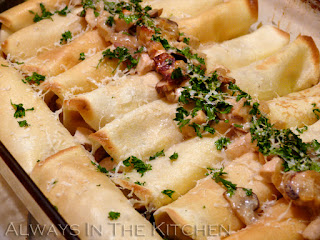
Shakshuka (aka Shakshouka, Chakchouka) is a dish of eggs poached in sauce, that sauce primarily consisting of a combination of at least any two of onions, peppers, and tomatoes. It is often credited as having originated in Tunisia, but versions of it appear all across Northern Africa, the Middle East, and the eastern Mediterranean, with variations that can include fava beans, artichokes, zucchini, or even diced potatoes. It is almost a wet hash, by North American standards, and is customizable to take advantage of whatever ingredients you need to use up. Serve with bread, for a filling, delightfully comforting meal.
I like versatile. It makes it that much more likely that I'll be able to throw it on the table on a Saturday morning without having to have done any specialized shopping.
Most of the versions that I've seen have been vegetarian ones, with any meats served separately as a side. However, I like a good one-pan dish, so I went ahead and added my merguez right into the pan (although it could have easily been served as links on the side).
The method is delightfully easy, particularly for someone who hasn't yet had their first cup of coffee: essentially, you just chop up the vegetables and saute them in a bit of olive oil until they become a bit saucy, and then crack eggs into little hollows that you make in the vegetable mixture (the back of a serving spoon does a good job at this). Continue to simmer gently until the eggs are cooked to your preferred level of doneness, decorate with parsley, then serve.
For optimal presentation, use a small skillet for each portion, and serve in the skillet at the table. Otherwise, be prepared for it to look a little raggedy as you separate the servings from a single pan.
Shakshuka
Serves 2
1/2 tablespoons olive oil
1 large onion, diced
1 jalapeno pepper, diced
1 red bell pepper, diced
2 cloves garlic, minced
398 mL diced tomatoes
1 teaspoon paprika
1/4 cup parsley
2 - 4 eggs
Heat the oil over high heat in a medium-large skillet. If you're using sausage, brown them quickly and remove to a plate. Stir in the garlic, onion, and bell pepper; cook and stir until the onion has softened and turned translucent, about 5 minutes. Add the tomatoes, paprika and jalapenos, and reduce the heat.
Stir and cook until heated through, using the back of a spoon to break up the tomatoes, about 10 minutes. If you're going to add sausage, slice up your browned sausages into chunks and throw them in now to finish cooking.
Make a nest for each egg by pressing a large spoon into the mixture in the pan. Add an egg to each nest. Cook until desired doneness of eggs. Finish under a broiler if you want it piping hot with a crisp top. Serve with bread - pita bread makes a great choice, but so does focaccia, sangak, or a nice French loaf.
Some versions use a little salty cheese, as well. I think this is quite a lot of food already, but a little crumbled feta, for example, would be very nice as a finish (especially for a meat-free version).































